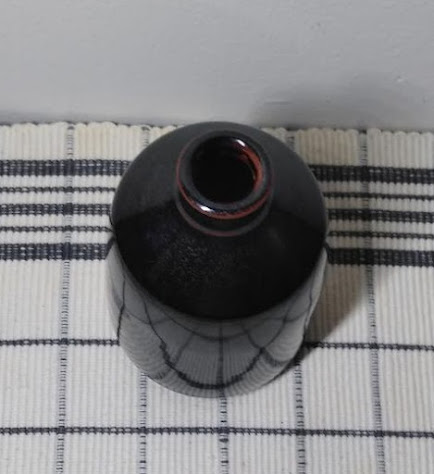156. John Charles Karrasch, 1934-2010, weedpot vase with Tenmoku glaze, ca. 1972
From the seller: “This lethal vase form was created in Reno, Nevada when John and Susan Karrasch worked together creating world class ceramics. John Karrasch is historically one of Nevada's most significant potters. From Vasefinder: John Charles Karrasch (1934-2010) was born in Missouri. He received the first technical B.F.A. in Ceramics from the University of Southern California in 1956, where he was a student of Susan Peterson and Vivika Heino. He received his M.F.A. from the Rhode Island School of Design in 1963, where he was a student of Lyle and Dorothy Perkins. John was a scholarship student at the Haystack Mountain School of Crafts. For a brief period, John studied glass technology with Harvey Littleton, when he was a student at the Toledo Museum of Art. He received a Georg Jensen Grant to study glass technology in Finland. John also worked as a marketing assistant for the League of New Hampshire. He was a designer for the Metlox Pottery. He has taught at Chouinard, as well the University of Nevada Reno to just mention a couple locations. John worked in several clay mediums, such as porcelain, stoneware and earthenware. He founded the Nevada Clay Arts Guild in the mid-1970s. Prior to 1961, we show John exhibiting at the Missouri State Fair in 1955 and 1956. In 1956, he had a one-man show at the Fisher Gallery of USC, Los Angeles, California. He also exhibited in one-man shows in Reno and Las Vegas in 1959 and exhibited at the Nevada State Silver Centennial, Virginia City, Nevada. John exhibited at the Syracuse Ceramic Nationals in 1962, 1964 and 1966.”
Light tan clay, brown Tenmoku glaze; base left unglazed. Weight: 396 g (14 oz). Width of rim: 3 cm (1-1/16 in); maximum width: 8.2 cm (3-1/4 in); width of foot ring: 5.7 cm (2-1/4 in). Height: 13.4 cm (5-1/4 in).
This sits on the foot ring, which is about 0.7 cm (1/8 in) high on the outside and about half that depth on the inside. The initials “JK” and “SK” and something resembling the Greek letter pi are written in black on the inside of the ring foot. Above the foot ring, the walls flare out in a straight line at about a 30-degree angle for about 1.7 cm (5/8 in). The maximum width is at the top of this section, about 1 cm (3/8 in) above the base. From there the walls slant inward in more or less a straight line to the shoulders, which are 9.4 cm (3-3/4 in) above the base. At the shoulders, the vase is 7 cm (2-3/4 in) in diameter. The walls then slant inward at a 45-degree angle to the base of the neck, which is 11.3 cm (4-1/2 in) above the vase. The diameter at the base of the neck is 3.3 cm (1-1/4 in). The neck is 1.7 cm (5/8 in) high. It slants inward to just under the rim, reaching a diameter of 2.5 cm (1 in) at the narrowest point. The rim is rolled outward. There is a paper sticker near the bottom on one side with “John Karrasch” and a logo matching his initials on the bottom of the vase. printed in black. This is very symmetrically shaped and very smooth to the touch.
With the exception of the ring foot and its interior, this was evenly glazed in a dark brown Tenmoku glaze. At the rim, the base of the neck, and around the bottom edge of walls, the glaze has pulled away from the clay and appears as lighter reddish-brown bands. In most lights, the vase looks almost black in color. Under a strong light, innumerable pinpricks of the lighter reddish-brown color show through in the characteristic “oil spots” of this glaze.
A beautiful example of very formal studio pottery with a flawless glaze, more typical of the output of studio potters in the 1970s than it is now.
Purchased from Charlie B. Studio of Carson City, Nevada, in October 2021. Charlie B. purchased the vase directly from the artist around 2005.






No comments:
Post a Comment